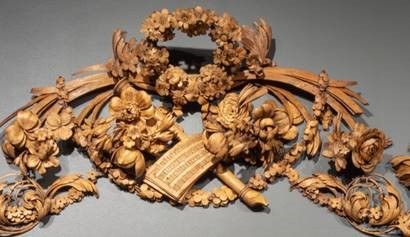Grinling Gibbons (1648-1721)
Bellmans are excited to include a Charles II carved limewood portrait plaque, attributed to the premier Baroque craftsman of his day, Grinling Gibbons (1648-1721) and his workshop, from circa 1680.
It’s a rare survivor to appear at auction that has provenance traceable back to the house it was created for, Cassiobury House, where the 1st Earl of Essex was one of the first to commission the fashionable Gibbons to decorate his house with extensive limewood carvings set against darker oak panelling in the 1680s. As with many other great country houses in the 20th Century, the contents of Cassiobury were dismantled in 1922 and the house demolished by 1927. However, records and photographs survive and it’s been possible to ascertain that this panel was located in the unique inner library or ‘cabinet of entertainment’ to the lower left of the fireplace below an elaborate overmantel, naturalistically carved and replete with identifiable sheet music, by Gibbons (now in the Chicago Institute of Art). Much of Gibbons’ work from Cassiobury was broken up, rearranged and sold to collectors in America. None of it was mentioned in the catalogue of 1922, but probably it was sold directly to dealers.
This panel was sold to Frederick Poke, who was an avid collector with connections to the furniture connoisseur R.W. Symonds, around the time of the contents sale in the early 1920s. The panel has remained within the same family until now.
The sitter has not been identified yet, but could be Lord Russell, Duke of Bedford. He and Arthur Capel, 1st Earl of Essex (1631-1683), who built Cassiobury, were connected as they both felt threatened by a Catholic sovereign (James II). Russell was executed for treason and the first Earl died in the Tower (by suicide or murder) whilst awaiting his trial.
While there were other portraits of family and close friends within the library, this was the only carved wood portrait. It is known that Lord Russell's painted portrait was also positioned in the same room.
Many art dealers bought at the auction and as a result the panels were dispersed and most were sold to the US and are now in institutions. Other parts of the library are now in Castle Hill (Ipswich, Massachusetts), while other works from Cassiobury Park went to Randolph Hearst's Beach House which he had built for Marion Davies in Santa Monica. The Getty and the Art Institute of Chicago have further works from the house and its grand staircase is part of the collection of the Metropolitan Museum of Art in New York.
Country Life made a reference to this plaque in 1914: "This however is not merely a frame but also an example of bas-relief carving in box-wood, the centre exhibiting the head of a man with a flowing Louis XIV wig and represented, not as usual in profile, but full face".
In April 1941 The Connoisseur mentioned the plaque as: "Another relic from destroyed Cassiobury is the oval medallion of a portrait of a man with a flowing curled wig (no.2). It originally hung in one of those small pleasant bays lined with books in the Library. The fine rendering of this medallion with its pierced floral frame points to the hand of the Master himself".
This lot sold on Wednesday 22nd November 2023 for £5200 (incBP*)







